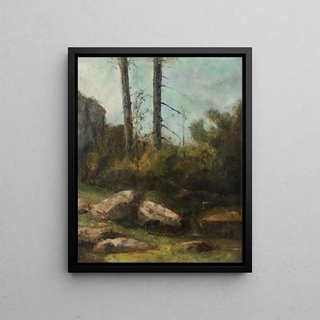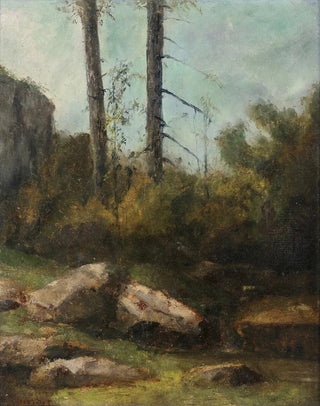Art print | La Garenne de Bussac en Saintonge - Gustave Courbet


View from behind

Frame (optional)
La Garenne de Bussac en Saintonge - Gustave Courbet – Captivating Introduction
La Garenne de Bussac en Saintonge, a quintessential work by Gustave Courbet, transports us to the heart of a rural landscape imbued with serenity and natural beauty. Painted in the 19th century, this canvas not only showcases the artist's exceptional talent but also his commitment to depicting reality as it is, far from the romantic ideals that prevailed in his era. Courbet, a major figure of realism, invites us to contemplate a suspended moment in time, where nature seems to reveal itself in all its splendor. The soft light bathing the scene, along with the delicate nuances of color, immerses us in a peaceful atmosphere conducive to reflection and escape.
Style and uniqueness of the work
Courbet's style is characterized by bold technique, blending vigorous brushstrokes with a palette of rich, nuanced colors. In La Garenne de Bussac en Saintonge, the artist succeeds in capturing the texture of foliage and undergrowth with remarkable precision, while maintaining a certain fluidity in composition. The work stands out for its naturalist approach, where each element of the landscape is treated with deep respect for nature. The interplay of light and shadow, as well as the way Courbet shapes forms, testify to his meticulous observation of the world around him. This painting does not merely depict a bucolic scene; it also evokes an intimate connection between man and nature, a recurring theme in the artist's oeuvre.
The artist and his influence
Gustave Courbet, born in 1819 in Franche-Comté, is often regarded as the pioneer of the realist movement. His rejection of academic conventions and his desire to depict life as it is positioned him in opposition to the artistic trends of his time. Courbet established himself as a provocative figure, challenging aesthetic norms and addressing subjects often overlooked by his contemporaries. His influence extends far beyond his era, inspiring generations of artists to explore social and political themes through the lens of realism. By celebrating the beauty of everyday life and

Matte finish

View from behind

Frame (optional)
La Garenne de Bussac en Saintonge - Gustave Courbet – Captivating Introduction
La Garenne de Bussac en Saintonge, a quintessential work by Gustave Courbet, transports us to the heart of a rural landscape imbued with serenity and natural beauty. Painted in the 19th century, this canvas not only showcases the artist's exceptional talent but also his commitment to depicting reality as it is, far from the romantic ideals that prevailed in his era. Courbet, a major figure of realism, invites us to contemplate a suspended moment in time, where nature seems to reveal itself in all its splendor. The soft light bathing the scene, along with the delicate nuances of color, immerses us in a peaceful atmosphere conducive to reflection and escape.
Style and uniqueness of the work
Courbet's style is characterized by bold technique, blending vigorous brushstrokes with a palette of rich, nuanced colors. In La Garenne de Bussac en Saintonge, the artist succeeds in capturing the texture of foliage and undergrowth with remarkable precision, while maintaining a certain fluidity in composition. The work stands out for its naturalist approach, where each element of the landscape is treated with deep respect for nature. The interplay of light and shadow, as well as the way Courbet shapes forms, testify to his meticulous observation of the world around him. This painting does not merely depict a bucolic scene; it also evokes an intimate connection between man and nature, a recurring theme in the artist's oeuvre.
The artist and his influence
Gustave Courbet, born in 1819 in Franche-Comté, is often regarded as the pioneer of the realist movement. His rejection of academic conventions and his desire to depict life as it is positioned him in opposition to the artistic trends of his time. Courbet established himself as a provocative figure, challenging aesthetic norms and addressing subjects often overlooked by his contemporaries. His influence extends far beyond his era, inspiring generations of artists to explore social and political themes through the lens of realism. By celebrating the beauty of everyday life and






